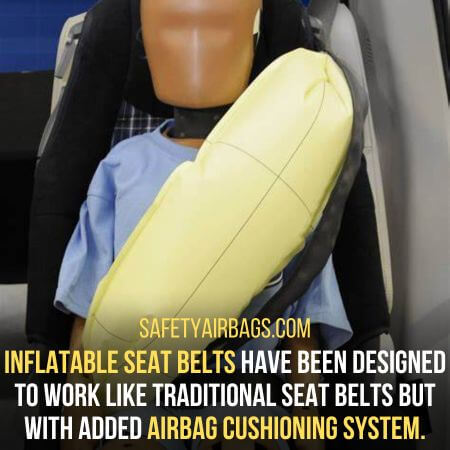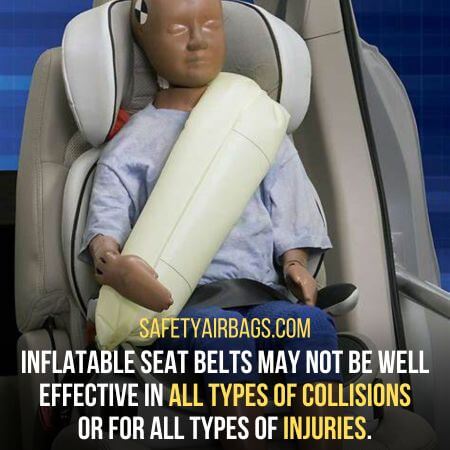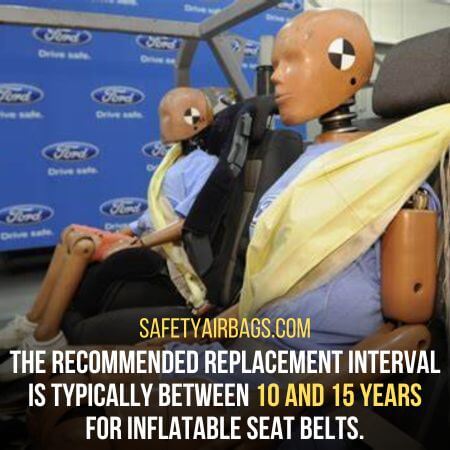Inflatable seat belts offer an innovative solution to the life-saving task of keeping passengers safe in vehicles.
What Will I learn
In this article, we’ll take a closer look at what inflatable seat belts are. We will learn how they can benefit the safety of drivers and passengers.
How Inflatable Seat Belts Work
Inflatable seat belts are a type of seat belt that uses airbags to provide additional protection to vehicle occupants in the event of a collision.
Traditional seat belts rely on a system of webbing to restrain occupants. Inflatable seat belts utilize an airbag that inflates upon impact to distribute the force of the collision across a wider area of the body.

Inflatable seat belts have been designed to work like traditional seat belts. But they have an added airbag cushioning system.
This makes for a more comfortable ride. However, it still provides the same level of protection as regular seat belts.
Let’s learn step by step how these advanced seat belts work:
1. Their Sensors Are Activated During a Collision:
The sensors are triggered when the car experiences a sudden stop during an accident. They detect changes in speed and pressure from the impact.
Other factors that determine the need for inflation are:
1. Direction Of Impact:
Inflatable seat belts can detect the direction of impact. This helps to calculate how much force needs to be absorbed by the airbag cushioning system.
For instance, the car is hit from the side. The force of impact will be greater. Therefore it will require increased cushioning for occupant safety.
2. Timing:
Inflatable seat belts also have a built-in timer that controls when to inflate. In addition, it can consider any delay in deployment due to wear and tear of components.
For instance, the inflation timing can be adjusted if the car is hit after a long period without use.
3. Severity Of Impact:
The sensors in the inflatable seat belts can detect the severity of impact. This way, they determine how much airbag cushioning is required to absorb the force.
For example, if the impact is mild, only a few airbags would be deployed. However, in more severe collisions, all the airbags will be triggered.
They will give maximum cushioning and occupant protection.
4. Occupant Position:
The sensors also take into account the occupant’s positioning in the vehicle. This helps to determine how much inflation is needed.
Also, that determines the proper deployment of airbags and seatbelts.
5. Speed Of Vehicle:
The sensors also take into account the speed of the vehicle. This helps to determine how much cushioning is needed in case of an impact.
Inflatable seat belts differ from traditional seat belts in providing more cushioning and comfort for occupants during a crash.
Traditional seat belts are designed to keep passengers restrained within their seats,
2. The Inflation Process:
Inflation for inflatable seat belts typically works through a small gas canister.
It is located within the seat belt assembly. The vehicle’s sensors detect a collision or sudden stop. A signal is sent to the gas canister, rapidly inflating the seat belt with gas.
The gas used for inflation is typically a special formulation of compressed nitrogen. It is stored at high pressure within the gas canister.
When the signal is received, a small pyrotechnic charge is ignited. It rapidly releases compressed gas from the canister.
The gas flows through a small nozzle or vent in the seat belt assembly. It causes the belt to inflate rapidly and expand.
This provides additional protection and support to the occupant. In addition, once the belt has fully inflated, it remains rigid for a short period.
Then it slowly deflates to its normal shape and size. Ultimately, the occupant is protected and held firmly in their seat.
Difference Of Inflatable Seatbelts from Traditional Seatbelts
Inflatable seat belts differ from traditional seat belts in several ways. Here are some of the key differences:
1. Inflatable seat belts use a small gas canister to rapidly inflate the belt in case of a collision or sudden stop. Traditional seat belts do not inflate.
2. Inflatable seat belts have a more complex design. They have a gas canister and vent, while traditional seat belts have a simpler design with a webbing strap.
3. Inflatable seat belts can be more comfortable than traditional seat belts. They distribute force over a larger body area, reducing pressure points.
4. Inflatable seat belts are designed to reduce the risk of chest injuries in the event of a collision. Traditional seat belts are primarily designed to prevent occupants from being ejected from the vehicle.
5. Inflatable seat belts are typically heavier than traditional seat belts. This is due to the additional components required for inflation.
6. Inflatable seat belts are only available in select vehicle models. Traditional seat belts are used in all vehicles.
In general, inflatable seat belts offer advantages over traditional seat belts regarding comfort and injury prevention.
Still, they are also more complex and heavier and not as widely available.
Types Of Inflatable Seat Belts
There are two additional types of inflatable seat belts: shoulder-mounted and lap-mounted.
1. Shoulder-Mounted Inflatable Seat Belts:
Shoulder-mounted inflatable seat belts protect the occupant’s head and neck in a collision.
The seat belt assembly includes a small gas canister near the shoulder. It inflates an airbag covering the occupant’s upper body and head.

This inflatable seat belt can help reduce the risk of head, neck, and spinal injuries in a collision.
It is typically used in the front seats of vehicles and is more commonly found in luxury vehicles.
2. Lap-Mounted Inflatable Seat Belts:
Lap-mounted inflatable seat belts protect the occupant’s hips and pelvis in a collision.
The seat belt assembly includes a small gas canister near the lap, which inflates an airbag covering the occupant’s hips and pelvis.
This inflatable seat belt can help reduce the risk of hip and pelvic injuries in a collision.
It is typically used in the rear seats of vehicles and is less common than shoulder-mounted inflatable seat belts.
In terms of effectiveness, both inflatable seat belts provide superior protection to the occupants compared to traditional seat belts.
Safety Benefits of Inflatable Seat Belts
Inflatable seat belts offer several safety benefits that traditional seat belts do not. Here are some of the key safety benefits of inflatable seat belts:
1. Reduced Risk of Fatalities and Serious Injuries:
Inflatable seat belts reduce the risk of fatalities and serious injuries in the event of a collision. According to research conducted by the National Highway Traffic Safety Administration (NHTSA) in 2017:
Using lap and shoulder belts can result in a 45% decrease the risk of a fatal injury to front-seat car occupants. Furthermore, the risk of sustaining a moderate to critical injury is reduced by 50%.
These statistics demonstrate the significant safety benefits that inflatable seat belts can provide.
2. Prevention of Specific Types of Injuries:
Inflatable seat belts are particularly effective at preventing certain types of injuries. For instance, they prevent head, neck, and spinal injuries in the case of shoulder-mounted inflatable seat belts.
Also, they prevent hip and pelvic injuries in the case of lap-mounted inflatable seat belts. These injuries can be particularly severe in high-speed or side-impact collisions. Inflatable seat belts can help reduce the severity of these injuries.
3. Complement Other Safety Features:
Inflatable seat belts work with other safety features, such as airbags, to provide maximum protection to the occupants.
The combination of inflatable seat belts and airbags can help reduce the risk of head, neck, and chest injuries in a collision.
In addition, inflatable seat belts can also help keep the occupant in the correct position during a collision. They reduce the risk of injury from hitting the dashboard or other interior surfaces.
4. Improved Comfort:
Inflatable seat belts can also improve occupants’ comfort, particularly during long trips. The airbags in inflatable seat belts are designed to distribute the impact force over a larger area.
Thus, they reduce the pressure on the chest and shoulders. This can help reduce fatigue and discomfort during long trips.
5. Greater Awareness and Usage:
Inflatable seat belts can also help increase awareness and usage of seat belts. Many people may not use their seat belts properly or consistently.
Still, inflatable seat belts’ added safety benefits and comfort may encourage more people to buckle up and use their seat belts correctly.
6. Increasing Availability:
The technology behind inflatable seat belts improves and becomes more widely adopted. They are becoming increasingly available in a wider range of vehicles.
More vehicle manufacturers offer inflatable seat belts as an option. They are becoming more accessible to a wider range of consumers, providing greater safety benefits to more people.
Inflatable seat belts offer significant safety benefits compared to traditional seat belts. They reduce the risk of fatalities and serious injuries, prevent specific injuries, and work with other safety features to provide maximum protection.
As a result, many vehicle manufacturers are beginning to offer inflatable seat belts as an option in their vehicles.
Limitations And Concerns
While inflatable seat belts offer significant safety benefits compared to traditional seat belts, there are also some limitations and concerns associated with this technology. Here are some of the main limitations and concerns related to inflatable seat belts:
1. Limited Effectiveness In Certain Situations:
Inflatable seat belts may not be effective in all types of collisions or for all types of injuries.

For example, lap-mounted inflatable seat belts may not be as effective in preventing chest injuries as shoulder-mounted seat belts.
In addition, inflatable seat belts may not be as effective in preventing injuries in certain collisions. For instance, rollover accidents or collisions with stationary objects.
2. Risk Of Injury From Deployment:
There is also a risk of injury associated with the deployment of inflatable seat belts. The airbags used in inflatable seat belts can deploy with a significant amount of force.
It can cause injury to the chest or neck if the occupant is not seated properly. In addition, seat belt deployment may cause bruising or other minor injuries.
3. Concerns With Counterfeit Or Defective Belts:
There is also a concern with counterfeit or defective inflatable seat belts. Counterfeit inflatable seat belts may sometimes be sold online or through other channels.
It may not meet the safety standards required by the vehicle manufacturer. Also, defective inflatable seat belts may not deploy properly or malfunction during a collision, which could increase the risk of injury.
4. Maintenance And Replacement:
Inflatable seat belts may also require more maintenance and replacement than traditional ones. For example, the airbags used in inflatable seat belts may need to be replaced after a collision.
They may also need replacement after several years to ensure they function properly. In addition, the components of inflatable seat belts may be more expensive to repair or replace than traditional seat belts.
5. Concerns With Child Safety Seats:
Inflatable seat belts may also raise concerns about using child safety seats. For example, some child safety seats are incompatible with inflatable seat belts.
Or they may require specific installation procedures to ensure proper use. In addition, the force of seat belt deployment may pose a risk to small children or infants in certain situations.
6. Cost:
Inflatable seat belts may be more expensive to manufacture and install than traditional ones.
This cost may be passed on to the consumer through higher vehicle prices. Or there may be additional fees for the option to have inflatable seat belts installed.
7. Limited Availability:
Inflatable seat belts are becoming more widely available in new vehicles. They may not be as readily available in older vehicles or certain vehicles, such as sports cars or pickup trucks.
This may limit the ability of some consumers to take advantage of the safety benefits of inflatable seat belts.
Vehicle owners should be aware of these limitations and concerns. They must follow proper maintenance and replacement procedures to ensure the safety of the occupants.
Maintenance and Replacement
Inflatable seat belts require regular maintenance and inspection to ensure that they function properly in the event of a collision.
Here is an overview of the maintenance and replacement requirements for inflatable seat belts:
1. Regular Maintenance and Inspection:
Vehicle owners should follow the maintenance and inspection recommendations provided by the vehicle manufacturer. They should ensure that the inflatable seat belts function properly.

This may include:
– Regular visual inspections
– Checking for signs of wear or damage, and
– Testing the deployment of the seat belts.
2. Recommended Replacement Interval:
Inflatable seat belts have a recommended replacement interval to ensure airbags function properly during a collision.
The recommended replacement interval varies by the vehicle manufacturer, but it is typically between 10 and 15 years.
Vehicle owners should consult the owner’s manual to determine the recommended replacement interval for their inflatable seat belts.
3. Process Of Replacing Inflatable Seat Belts:
If the inflatable seat belts need to be replaced, the process typically involves replacing the entire seat belt assembly.
This includes removing the old seat belt and airbag assembly and installing a new one.
The replacement process may require specialized tools and expertise. So it is recommended that vehicle owners have the replacement performed by a qualified technician.
4. Associated Costs:
The cost of replacing an inflatable seat belt can vary. It depends on the make and model of the vehicle, as well as the specific components that need to be replaced.
In general, the cost of replacing an inflatable seat belt is between $400 to $1000.
Future Developments
Inflatable seat belt technology is continually evolving to improve vehicle safety and reduce the risk of injury in a collision.
Vehicle manufacturers and researchers continue to invest in developing inflatable seat belt technology. They improve its performance and effectiveness.
Ongoing research includes using advanced materials. There can be stronger fabrics and more durable airbag components. It may also include developing new sensor technologies to better detect and respond to collision events.
Emerging trends in seat belt design include using advanced sensors. They detect collision events faster and trigger the deployment of inflatable seat belts.
These sensors may include accelerometers or other types of sensors. They can detect changes in velocity or other parameters associated with a collision.
Advanced sensors can help improve seat belt deployment accuracy and reduce the risk of injury to vehicle occupants.
Using new materials is also a key area of focus in seat belt design. New materials may also help reduce the seat belt’s weight. This can contribute to improved fuel efficiency and lower emissions.
Conclusion:
Inflatable seat belts have revolutionized vehicle safety. They provide occupants with a more effective and comfortable restraint system.
In addition, relatable seat belts reduce the risk of injury in a collision, particularly in preventing head, neck, and chest injuries.
There is an increasing number of vehicles on the road and the growing complexity of the traffic environment. So it is important to have effective and reliable safety systems.
Inflatable seat belts provide a key element of this safety net. They help to protect vehicle occupants in the event of a collision.
Moreover, research says that inflatable seat belts can significantly reduce the risk of fatal and severe injuries in motor vehicle accidents.
Inflatable seat belts are also more comfortable to wear than traditional seat belts. This makes them a critical component in promoting vehicle safety.
